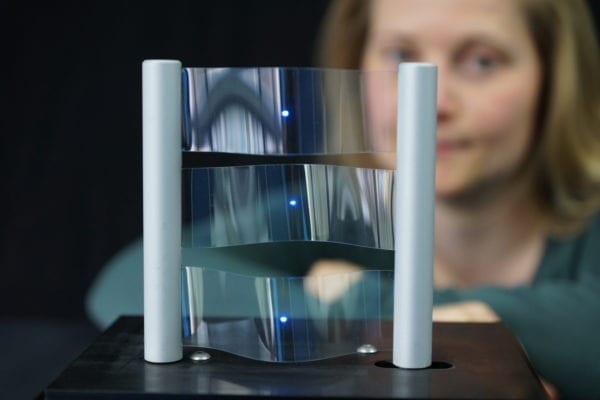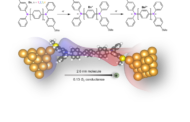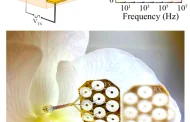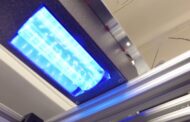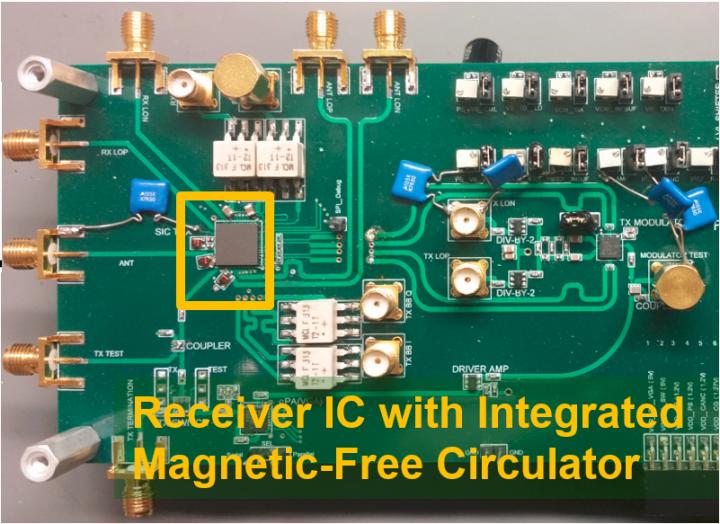
This is the first CMOS full duplex receiver IC with integrated magnetic-free circulator.
CREDIT
Negar Reiskarimian, Columbia Engineering
Columbia Engineers develop the first on-chip RF circulator that doubles WiFi speeds with a single antenna — could transform telecommunications
Last year, Columbia Engineering researchers were the first to invent a technology–full-duplex radio integrated circuits (ICs)–that can be implemented in nanoscale CMOS to enable simultaneous transmission and reception at the same frequency in a wireless radio. That system required two antennas, one for the transmitter and one for the receiver. And now the team, led by Electrical Engineering Associate Professor Harish Krishnaswamy, has developed a breakthrough technology that needs only one antenna, thus enabling an even smaller overall system. This is the first time researchers have integrated a non-reciprocal circulator and a full-duplex radio on a nanoscale silicon chip. The circulator research is published online April 15 in Nature Communications (DOI is 10.1038/NCOMMS11217) and the paper detailing the single-chip full-duplex radio with the circulator and additional echo cancellation was presented at the 2016 IEEE International Solid-State Circuits Conference on February 2.
“This technology could revolutionize the field of telecommunications,” says Krishnaswamy, director of the Columbia High-Speed and Mm-wave IC (CoSMIC) Lab. “Our circulator is the first to be put on a silicon chip, and we get literally orders of magnitude better performance than prior work. Full-duplex communications, where the transmitter and the receiver operate at the same time and at the same frequency, has become a critical research area and now we’ve shown that WiFi capacity can be doubled on a nanoscale silicon chip with a single antenna. This has enormous implications for devices like smartphones and tablets.”
Krishnaswamy’s group has been working on silicon radio chips for full duplex communications for several years and became particularly interested in the role of the circulator, a component that enables full-duplex communications where the transmitter and the receiver share the same antenna. In order to do this, the circulator has to “break” Lorentz Reciprocity, a fundamental physical characteristic of most electronic structures that requires electromagnetic waves travel in the same manner in forward and reverse directions.
“Reciprocal circuits and systems are quite restrictive because you can’t control the signal freely,” says PhD student Negar Reiskarimian, who developed the circulator and is lead author of the Nature Communications paper. “We wanted to create a simple and efficient way, using conventional materials, to break Lorentz Reciprocity and build a low-cost nanoscale circulator that would fit on a chip. This could open up the door to all kinds of exciting new applications.”
The traditional way of breaking Lorentz Reciprocity and building radio-frequency circulators has been to use magnetic materials such as ferrites, which lose reciprocity when an external magnetic field is applied. But these materials are not compatible with silicon chip technology, and ferrite circulators are bulky and expensive. Krishnaswamy and his team were able to design a highly miniaturized circulator that uses switches to rotate the signal across a set of capacitors to emulate the non-reciprocal “twist” of the signal that is seen in ferrite materials. Aside from the circulator, they also built a prototype of their full-duplex system–a silicon IC that included both their circulator and an echo-cancelling receiver–and demonstrated its capability at the 2016 IEEE International Solid- State Circuits Conference this past February.
“Being able to put the circulator on the same chip as the rest of the radio has the potential to significantly reduce the size of the system, enhance its performance, and introduce new functionalities critical to full duplex,” says PhD student Jin Zhou, who integrated the circulator with the full-duplex receiver that featured additional echo cancellation.
Non-reciprocal circuits and components have applications in many different scenarios, from radio-frequency full-duplex communications and radar to building isolators that prevent high-power transmitters from being damaged by back-reflections from the antenna. The ability to break reciprocity also opens up new possibilities in radio-frequency signal processing that are yet to be discovered. Full-duplex communications is of particular interest to researchers because of its potential to double network capacity, compared to half-duplex communications that current cell phones and WiFi radios use. The Krishnaswamy group is already working on further improving the performance of their circulator, and exploring “beyond-circulator” applications of non-reciprocity.
“What really excites me about this research is that we were able to make a contribution at a theoretically fundamental level, which led to the publication in Nature Communications, and also able to demonstrate a practical RF circulator integrated with a full-duplex receiver that exhibited a factor of nearly a billion in echo cancellation, making it the first practical full-duplex receiver chip and which led to the publication in the 2016 IEEE ISSCC,” Krishnaswamy adds. “It is rare for a single piece of research, or even a research group, to bridge fundamental theoretical contributions with implementations of practical relevance. It is extremely rewarding to supervise graduate students who were able to do that!”
Learn more: WiFi capacity doubled at less than half the size
The Latest on: WiFi speed
[google_news title=”” keyword=”WiFi speed” num_posts=”10″ blurb_length=”0″ show_thumb=”left”]
via Google News
The Latest on: WiFi speed
- Random Apple ID password resets are plaguing the interneton April 27, 2024 at 8:38 am
Apple got the weekend off to a weird start for some of its users.
- Best Internet Providers in Flint, Michiganon April 27, 2024 at 5:05 am
The fastest internet speed in Flint also comes from Xfinity and its 1,200Mbps plan, available across the cable ISP’s broad service area. Our methodology CNET considers speeds, pricing, customer ...
- Mountain View looks to expand high-speed internet accesson April 26, 2024 at 1:32 pm
The city is assessing Mountain View's broadband needs, as federal and state programs offer money for high-speed internet infrastructure.
- Study finds affordability, not infrastructure, is major barrier to high-speed internet connectivityon April 26, 2024 at 10:14 am
With a federal subsidy that has provided less expensive or free broadband internet to more than 23 million American households due to run out of money by the end of May, a new University of ...
- FCC votes to restore net neutrality – what that could mean for your internet speedon April 26, 2024 at 6:09 am
The FCC has voted to reinstitute net neutrality regulations – why this could be great news for your internet speed.
- Campus Wi-Fi changes to increase speed and securityon April 26, 2024 at 2:39 am
Dartmouth Information, Technology and Consulting is instituting Wi-Fi changes that will make network connection faster and more secure.
- Net neutrality is back: FCC bars broadband providers from meddling with internet speedon April 25, 2024 at 12:18 pm
U.S. regulators are reviving a rescinded rule, laying the groundwork for for a major court fight with the broadband industry.
- Today's FCC's net neutrality vote affects your internet speed. We explainon April 25, 2024 at 10:23 am
Under Trump, the FCC had argued the net neutrality rules were unnecessary, blocked innovation and resulted in a decline in network investment by internet service providers, a contention disputed by ...
- New FCC rules changing your internet speedon April 25, 2024 at 4:20 am
Net neutrality is making a comeback with an FCC vote Thursday, which means internet providers will not be able to speed up or even slow down certain web traffic. Now, new FCC rules ban blocking, ...
- NEPA awarded $42.5M for high-speed internet access to grant moneuyon April 19, 2024 at 3:01 pm
The Pennsylvania Broadband Development Authority (PBDA) announced Friday, that NEPA s being awarded $42.5 million to increase access to reliable, high-speed internet, ...
via Bing News

